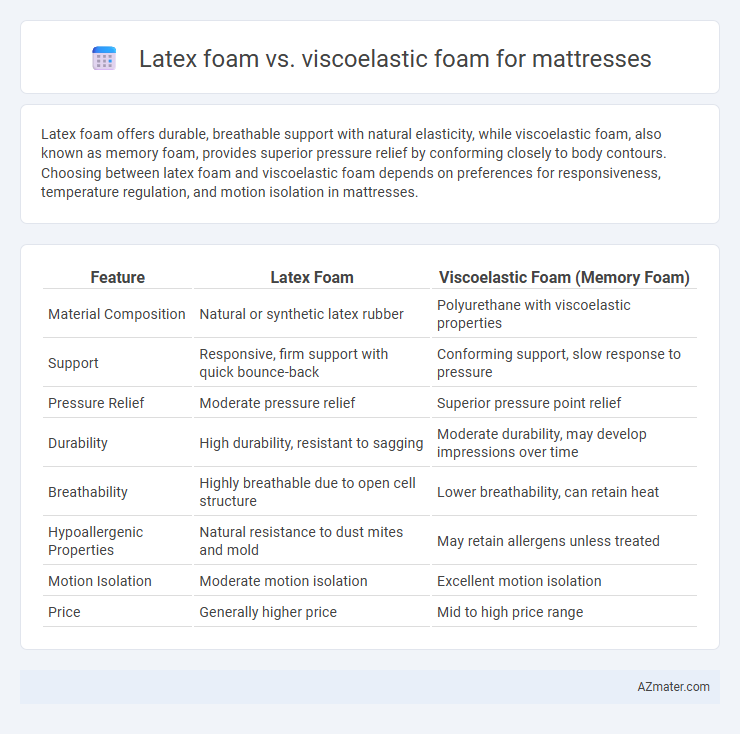Latex foam offers durable, breathable support with natural elasticity, while viscoelastic foam, also known as memory foam, provides superior pressure relief by conforming closely to body contours. Choosing between latex foam and viscoelastic foam depends on preferences for responsiveness, temperature regulation, and motion isolation in mattresses.
Table of Comparison
| Feature | Latex Foam | Viscoelastic Foam (Memory Foam) |
|---|---|---|
| Material Composition | Natural or synthetic latex rubber | Polyurethane with viscoelastic properties |
| Support | Responsive, firm support with quick bounce-back | Conforming support, slow response to pressure |
| Pressure Relief | Moderate pressure relief | Superior pressure point relief |
| Durability | High durability, resistant to sagging | Moderate durability, may develop impressions over time |
| Breathability | Highly breathable due to open cell structure | Lower breathability, can retain heat |
| Hypoallergenic Properties | Natural resistance to dust mites and mold | May retain allergens unless treated |
| Motion Isolation | Moderate motion isolation | Excellent motion isolation |
| Price | Generally higher price | Mid to high price range |
Introduction to Mattress Foam Types
Latex foam mattress offers natural elasticity and durability, promoting excellent support and breathability, ideal for sleepers seeking a responsive surface. Viscoelastic foam, often known as memory foam, excels in contouring to the body's shape, providing pressure relief and motion isolation for enhanced comfort. Choosing between latex and viscoelastic foam depends on preferences for firmness, heat retention, and hypoallergenic properties, impacting overall sleep quality.
What is Latex Foam?
Latex foam is a natural or synthetic material derived from rubber tree sap, known for its resilience, breathability, and durability in mattresses. It offers excellent support by conforming to the body's shape while maintaining a buoyant, springy feel that reduces pressure points and promotes healthy spinal alignment. Latex foam also resists dust mites and mold, making it a hypoallergenic and eco-friendly option compared to viscoelastic foam, which is typically made from petroleum-based memory foam with slower response and heat retention characteristics.
What is Viscoelastic (Memory) Foam?
Viscoelastic foam, commonly known as memory foam, is a polyurethane material enhanced with viscoelastic properties that allow it to respond to body heat and pressure by softening and conforming closely to the body's shape. This foam provides excellent pressure relief and motion isolation, making it ideal for individuals seeking comfort and support that adapts to their unique sleeping position. Unlike latex foam, which is more resilient and buoyant, viscoelastic foam offers a slower response to movement, enhancing pressure point reduction and improving overall sleep quality.
Comfort and Support Comparison
Latex foam offers buoyant support and natural responsiveness, making it ideal for sleepers who prefer a firmer feel with consistent pressure relief. Viscoelastic foam, or memory foam, conforms closely to body contours, providing exceptional comfort by evenly distributing weight and minimizing pressure points. The contrast in support lies in latex foam's quick recovery and durability versus memory foam's slow response and superior motion isolation.
Durability and Longevity
Latex foam mattresses are known for their exceptional durability, often maintaining support and resilience for 10 to 15 years due to the natural elasticity of latex materials. Viscoelastic foam, also called memory foam, typically offers comfort by conforming to body shape but tends to show signs of wear and sagging within 7 to 10 years because of its lower density and slower recovery rate. Choosing latex foam ensures extended mattress longevity and consistent performance, making it a preferred option for long-term investment in sleep quality.
Temperature Regulation and Breathability
Latex foam offers superior temperature regulation and breathability due to its natural open-cell structure and inherent moisture-wicking properties, promoting airflow and a cooler sleep environment. Viscoelastic foam, or memory foam, tends to retain heat as it responds to body temperature and pressure, often resulting in a warmer sleeping surface. For sleepers prioritizing temperature control, latex foam provides enhanced cooling capabilities compared to the heat-trapping nature of viscoelastic foam.
Motion Isolation and Noise Reduction
Latex foam offers excellent motion isolation due to its natural elasticity, minimizing disturbance from partner movements and providing consistent support throughout the mattress. Viscoelastic foam, commonly known as memory foam, excels in noise reduction as it absorbs sound vibrations effectively, ensuring a quieter sleep environment. Both foams contribute to reducing motion transfer, but latex tends to be more resilient and responsive, while viscoelastic foam contours closely to the body for superior noise dampening.
Allergies and Eco-Friendliness
Latex foam mattresses are naturally hypoallergenic, resistant to dust mites, mold, and bacteria, making them ideal for allergy sufferers, while viscoelastic (memory) foam can sometimes trap allergens due to its dense structure. Eco-friendliness favors natural latex, derived from rubber tree sap, offering biodegradable and sustainable qualities compared to viscoelastic foam, which is petroleum-based and less environmentally friendly. Choosing latex foam supports better indoor air quality and reduces ecological impact, aligning with health-conscious and eco-aware consumer preferences.
Price Differences and Value
Latex foam mattresses typically cost more than viscoelastic (memory) foam due to natural materials and durability, offering long-term value through resilience and breathability. Viscoelastic foam is generally more affordable, providing excellent pressure relief and contouring but may have a shorter lifespan and retain heat more. Choosing between them depends on budget priorities, where latex offers premium value and longevity, while visco foam delivers cost-effective comfort.
Choosing the Best Foam for Your Sleep Needs
Latex foam offers responsive support and natural breathability, making it ideal for sleepers seeking durability and cooler sleep conditions. Viscoelastic foam, commonly known as memory foam, provides superior pressure relief and contouring for those with joint pain or preference for cradling comfort. Selecting the best foam depends on personal sleep preferences, such as firmness level, temperature regulation, and specific orthopedic needs.

Infographic: Latex foam vs Viscoelastic foam for Mattress
 azmater.com
azmater.com